With rainforest, waterfalls, beaches, and mountains, the Olympic Peninsula in Washington is one of the most unique places in the United States. This guide walks you through how to make the most of your trip by going over the best things to do in Olympic National Park.
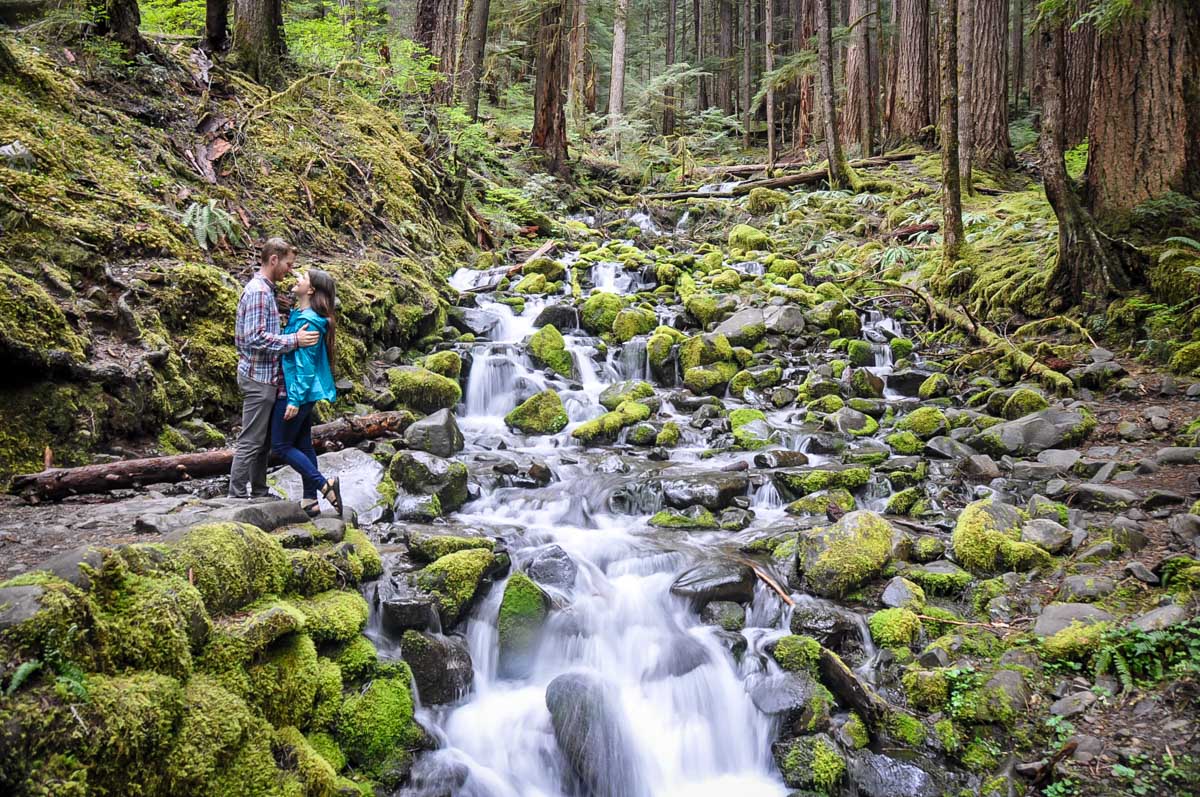
With temperate rainforests, snow capped mountains, and driftwood-strewn beaches, Olympic National Park is the stuff that dreams are made of. Those famous PNW clouds hang low, giving the whole area an ethereal quality. And yes, waterfalls really are everywhere on the Olympic Peninsula.
There are tons of fun things to do in Olympic National Park! If you’re looking for an adventurous road trip, the OP is one of the very best places to visit in Washington State.
From the Insta-famous beaches to seldom-visited backcountry trails, visiting the Olympic Peninsula makes an epic road trip no matter what type of adventure you’re looking for!
Olympic National Park Guide
For more tips and advice for planning your trip to Olympic National Park, jump to the following sections (or just keep scrolling to see it all!).
- Park overview
- Best time to visit
- How many days to spend in the park
- How to get there
- Entrance fees and tickets
- Getting around in the park
- Olympic National Park map
- Where to stay
- What to pack
- Round up of things to do in Olympic National Park
Ultimate PNW Bucket List!
Traveling around the Pacific Northwest? We have just what you need!
We’ve created the ultimate PNW Bucket List, filled with fun and unique adventures. From epic outdoor escapes to off-the-beaten-path foodie experiences, we have a little something for every type of traveler!
Go ahead and grab your copy now. It’s free, so what do you have to lose?!
Best things to do in Olympic National Park
If you’re looking for the very best things to do in Olympic National Park, here are our top recommendations:
- Explore the Hoh Rainforest
- Discover Hurricane Ridge
- Hike to Sol Duc Falls
- Camp on Shi Shi Beach
- Hike Mount Storm King
Keep reading for more detailed information on each of these activities and more ideas of fun things to do in Olympic National Park.
1. Explore the Hoh Rainforest
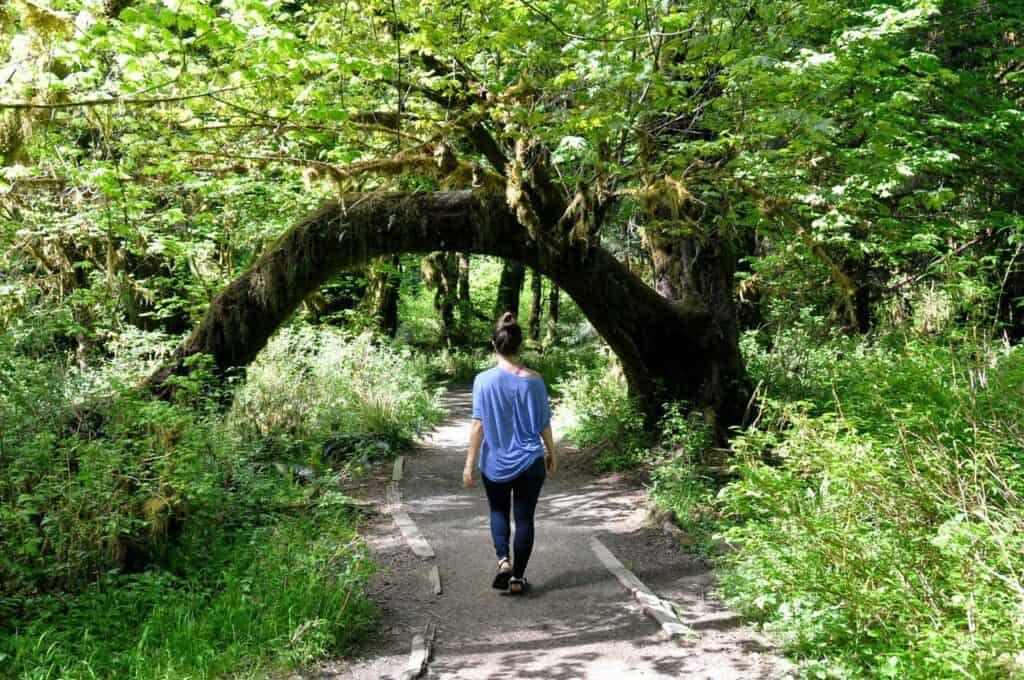
Most first-time visitors to the Olympic Peninsula don’t leave without a stop at the Hoh Rainforest. With a few different walks of varying lengths to choose from, it’s easy to see why this is one of the top things to do in Olympic National Park.
Keep in mind that the easily accessible trails are heavily trafficked, meaning this may be one of the more crowded stops on your time in the OP.
When we were there, it was a beautiful, sunny day. Don’t worry though if the weather isn’t great during your visit. I remember visiting as a child on an overcast rainy day, and the forest had a completely different vibe. (I think I actually preferred the drizzly weather because it made everything seem more lush and dramatic!)
Tip: If you have a short amount of time and have to pick just one trail to walk, the Hall of Mosses trail is said to be the most worthwhile with limited time.
2. Discover Hurricane Ridge
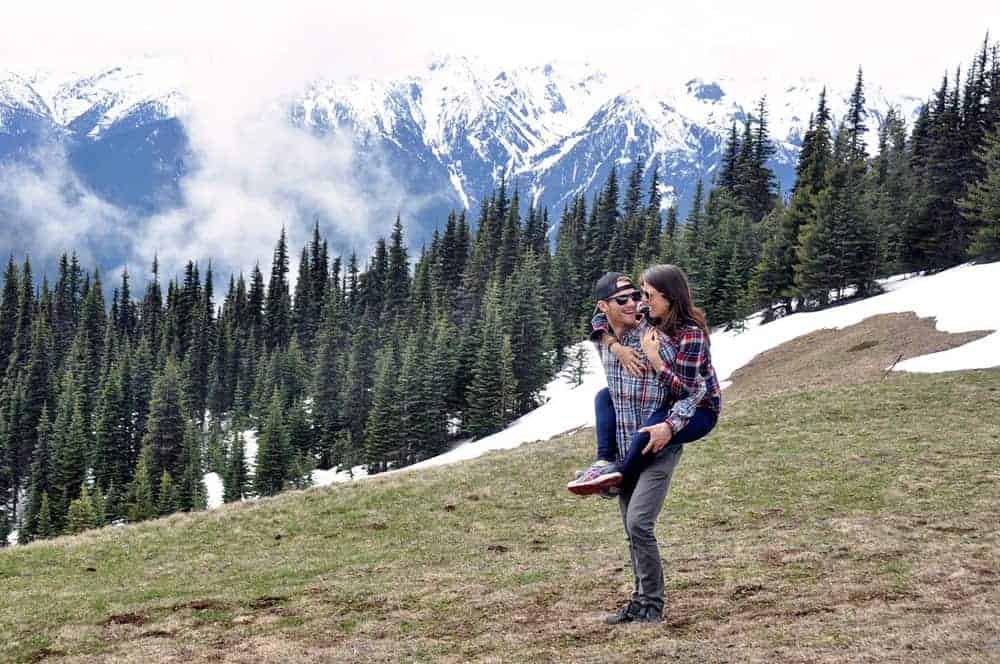
A stop at Hurricane Ridge will teach you the meaning of the phrase, “the mountains are calling.”
This dramatic landscape will make you feel worlds away from bustling Seattle, yet it is incredibly accessible. The drive up Hurricane Ridge Road to the Hurricane Ridge Visitor Center is breathtaking, as is the view at the top.
Explore the nearby trails, like the easy 3-mile hike up Hurricane Hill, for more epic backdrops, and take advantage of one of the many picnic tables in the vicinity. Pack a lunch to be enjoyed with postcard-worthy views. Oh, and don’t forget to bring your camera!
Tip: If you’re planning on staying on any of the beaches on the OP (which I would highly recommend), make sure to get your permits and bear canister at the Olympic Peninsula Visitor Center on your way to or from Hurricane Ridge.
Note: This area can look dramatically different depending on the time of year you visit. When we were there in mid-May, there was still lots of snow and you needed snowshoes to access some of the hiking paths. Later in the summer, however, the trails are covered in wildflowers.
3. Hike to Sol Duc Falls
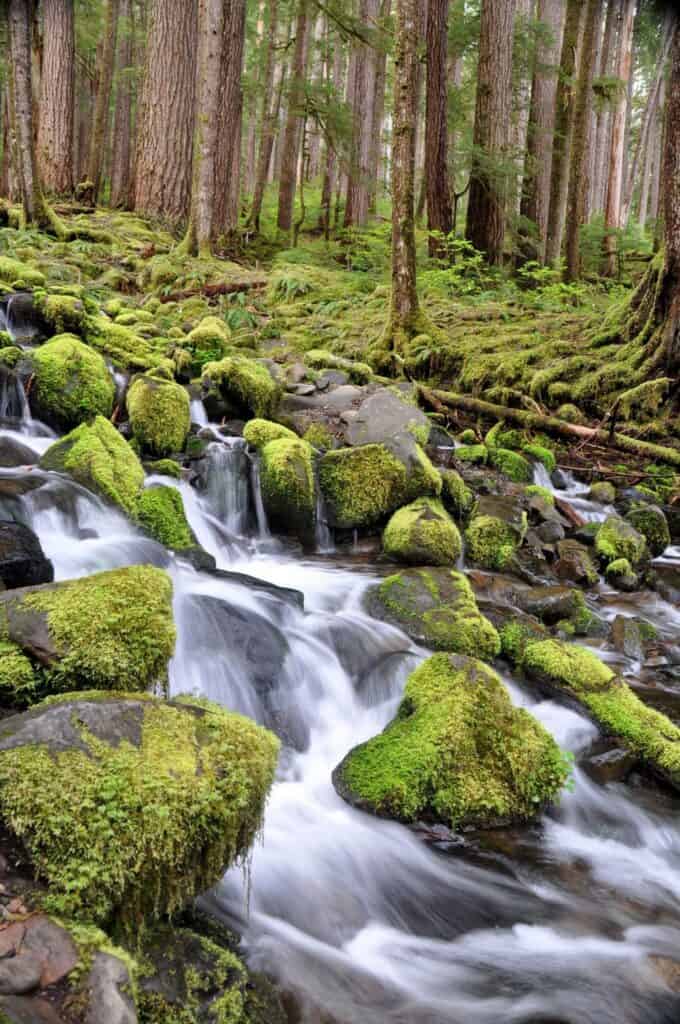
- Distance: 1.6 miles, out and back
- Elevation gain: 255 ft
- Difficulty: Easy
- View our trail guide
These stunning falls look like something out of Fern Gully (remember that movie?!). There are two main parts to the falls; the first section you’ll walk past is smaller and filled with moss-covered rocks.
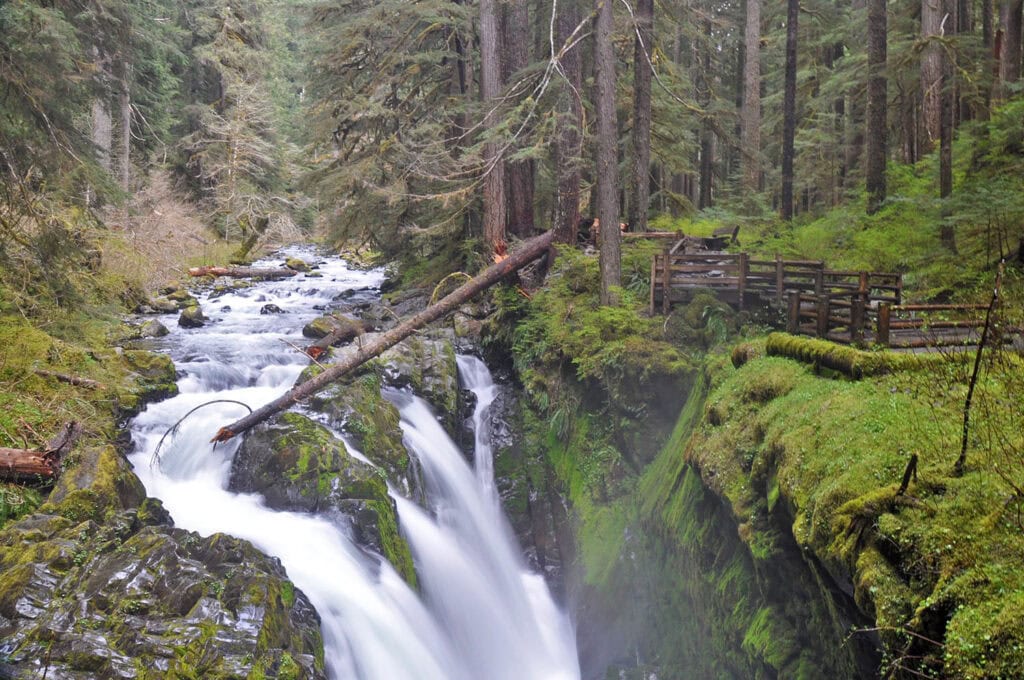
Walk a bit further and you’ll reach the main part of the falls, which is larger. You’ll definitely want to see both parts, but we actually enjoyed the first section more!
Planning a family hike? Don’t miss our essential tips for hiking with a toddler!
4. Camp on Shi Shi Beach
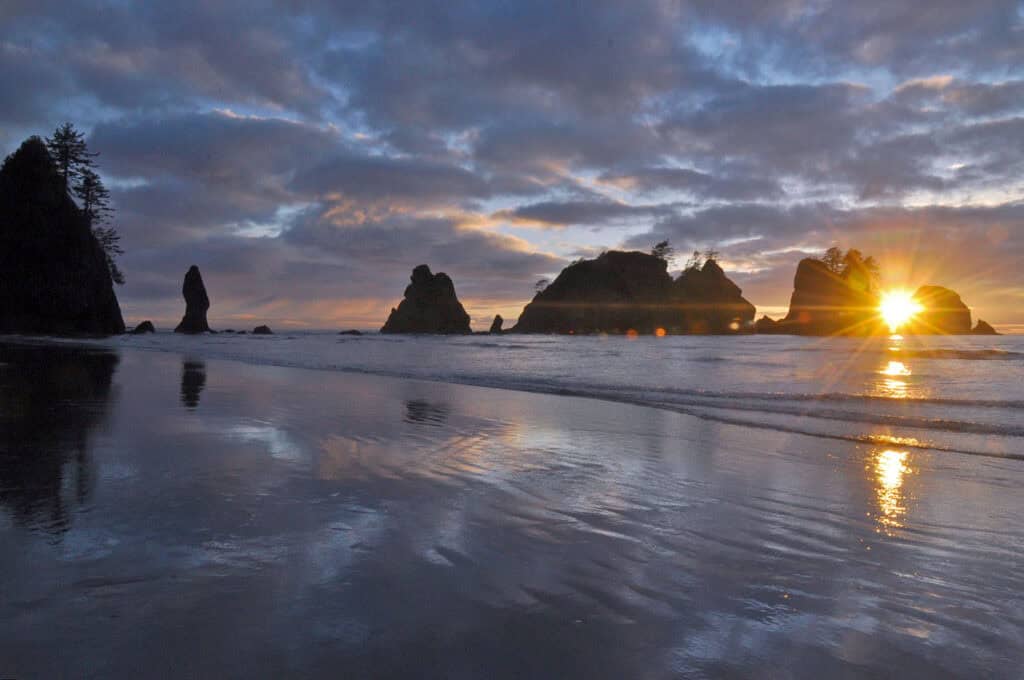
To get to this somewhat remote beach, you’ll need to hike 2 miles on a muddy, jungly path on the Makah Indian Reservation.
Once you reach the ocean, it is another 2 miles of walking on the sand to get to the dramatically stunning sea stacks. But oh man, is it worth it for the sunset.
Being that it is quite a trek, we’d recommend a stop here only if you are camping overnight, or if you intend to spend the whole day exploring.
Do it yourself: We put together an entire guide to camping on Shi Shi Beach with everything you need to know.
5. Hike Mount Storm King
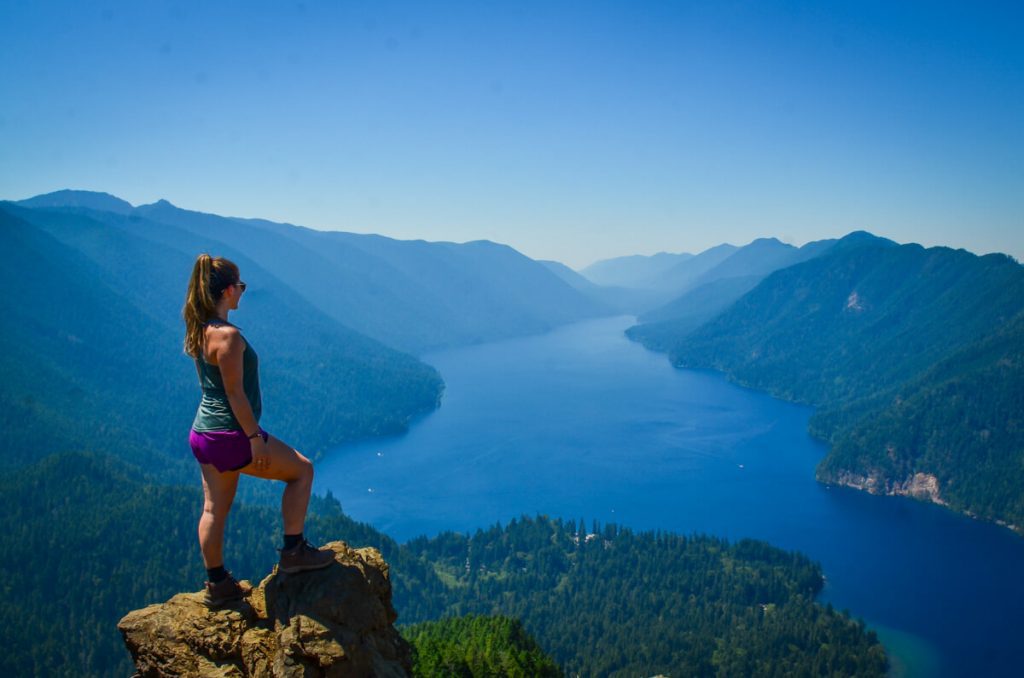
- Distance: 5.3 miles, out and back
- Elevation gain: 2,076 ft
- Difficulty: Challenging
- Trail notes on All Trails
This short but grueling trail is one of the best hikes in Olympic National Park for good reason… Just look at those views!
Though the trail is relatively short, this hike is not to be underestimated. The final stretch involves pulling yourself up using a series of ropes to reach the summit.
If you’re up for a challenge, you’ll be rewarded with the most incredible views of Crescent Lake and the Strait of Juan de Fuca.
Check out our guide to the Mount Storm King hike on our sister site for all the info you need to plan your hike.
6. Visit Lake Crescent
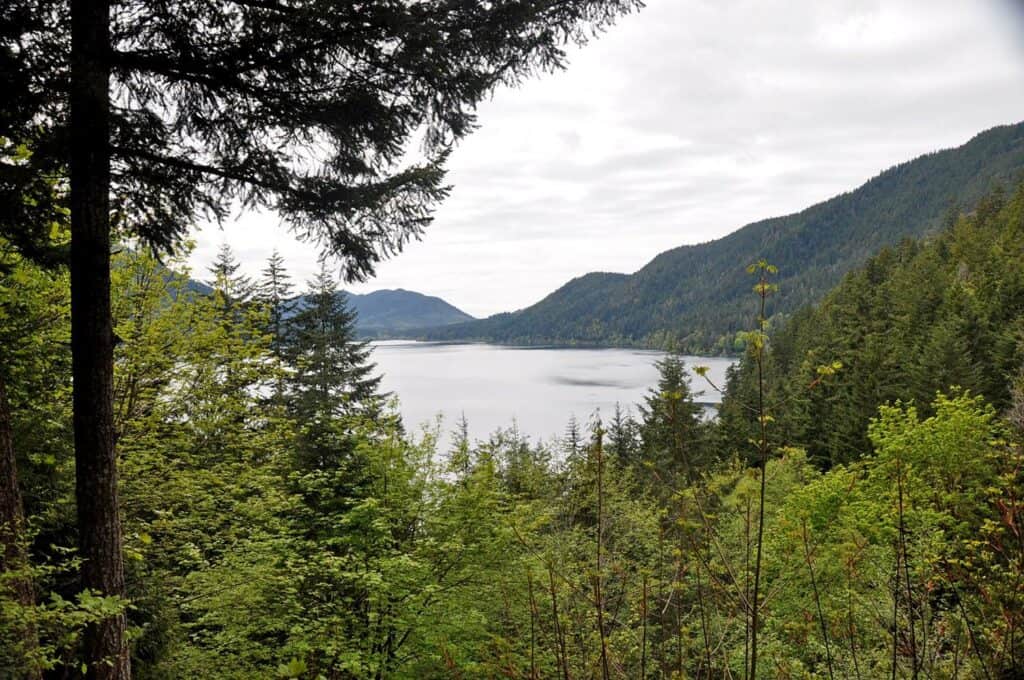
This lake, flanked by mountains, has a few nice lookout points and you’ll likely drive past it on your way into the peninsula.
Getting hungry? Granny’s Cafe is a good option for a quick bite near Lake Crescent. It has the nostalgic feel of a cozy, small-town diner and reasonable prices to match. For a sweet treat, try the blackberry pie and soft serve ice cream!
7. Head to the beaches in La Push
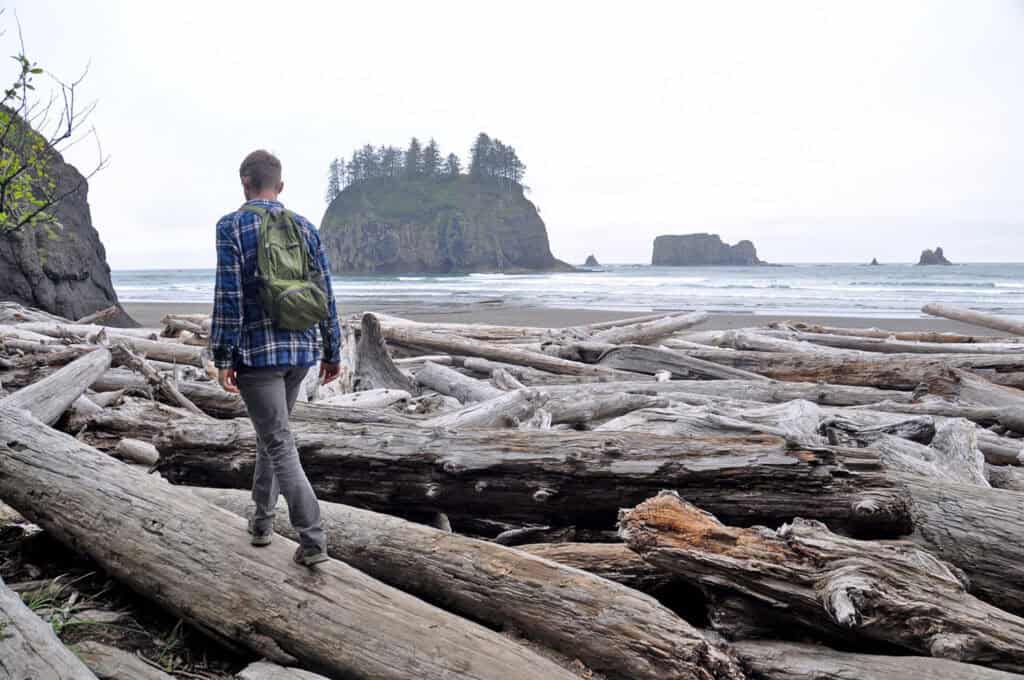
The beaches in La Push on the Pacific coast of the OP are simply called First Beach, Second Beach and Third Beach.
While they may not have very creative names, these Olympic National Park beaches are well-known and can be found on just about every PNW photographer’s Instagram page. They’re popular for a reason.
Bring a tent, a guitar and a surfboard, or just a blanket and some snacks. However you choose to enjoy the rustic, driftwood-strewn beaches, you’re in for a good time. But know that you definitely won’t be alone.
The accessibility of these beaches mean that you’ll be sharing the view with hippies hanging out in their half tent/half driftwood shelters, families on day trips, surfers, and photography classes.
The mishmash of people coming together makes for a cool vibe, and the dramatic seascape doesn’t hurt either!
Psst! Traveling with kids? Check out these family-friendly beaches on the Olympic Peninsula.
8. Check out the sea stacks at Ruby Beach
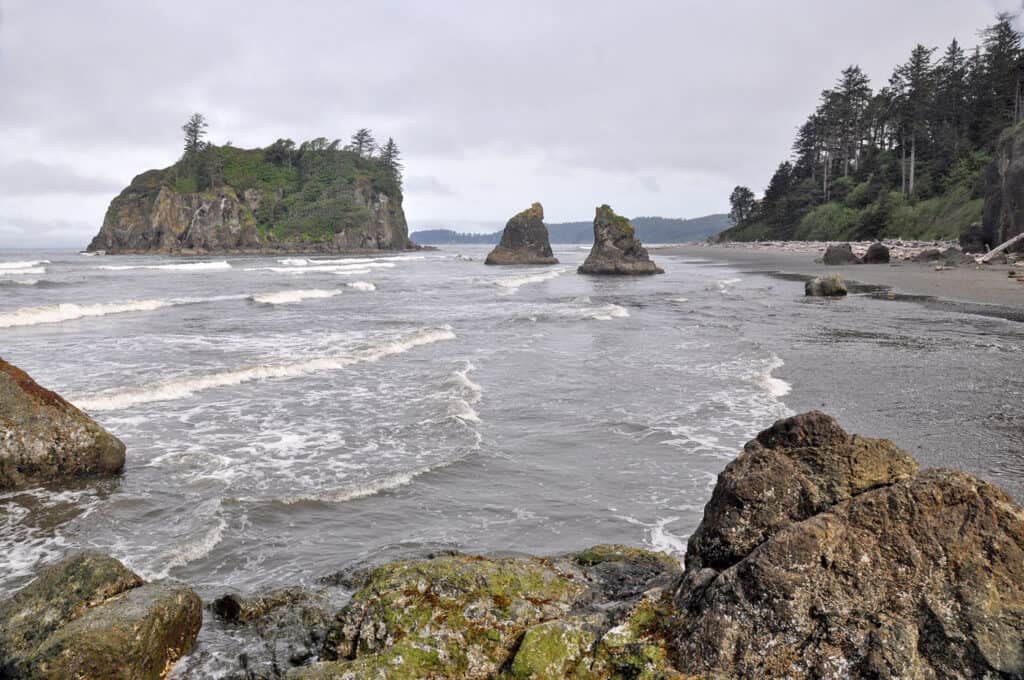
Just a short walk from the parking lot, Ruby Beach is a great place to stop for a picnic lunch amongst sea stacks and driftwood. Unlike Shi Shi and the beaches in La Push though, camping is not allowed at Ruby Beach.
9. Go backpacking in Enchanted Valley
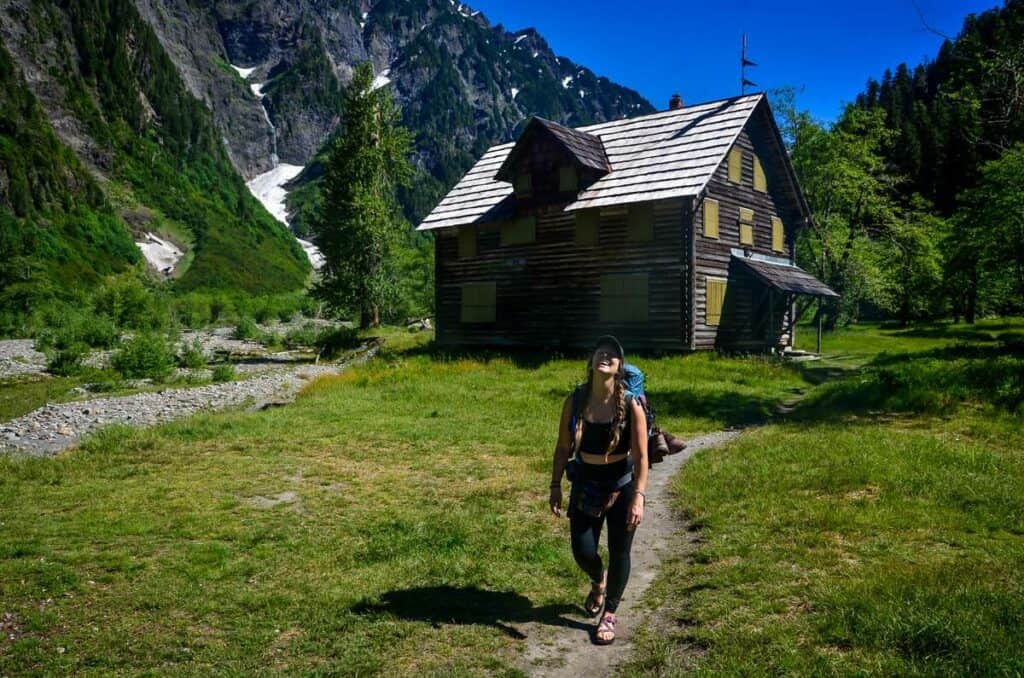
- Distance: 27 miles out-and-back (13.5 miles from the trailhead to the Chalet)
- Elevation gain: 1,400 ft
- Difficulty: Moderate (pretty flat but a long hike)
- Recommended duration: 3 days, 2 nights
One of the most underrated hikes in Olympic National Park is The Enchanted Valley Trail, which follows the Quinault River into a valley flanked with mountains on both sides.
The 27-mile out-and-back hike follows the Quinault River and takes you through old growth forests, past waterfalls, mountain views and even climbing over a rustic bridge or two. Ultimately winding up in a majestic wide open valley filled with wildlife like black bears and elk.
The Enchanted Valley Chalet, an iconic landmark at the end of the trek, is the main attraction surrounded by mountains with cascading waterfalls. The views are extraordinary and a sight to behold!
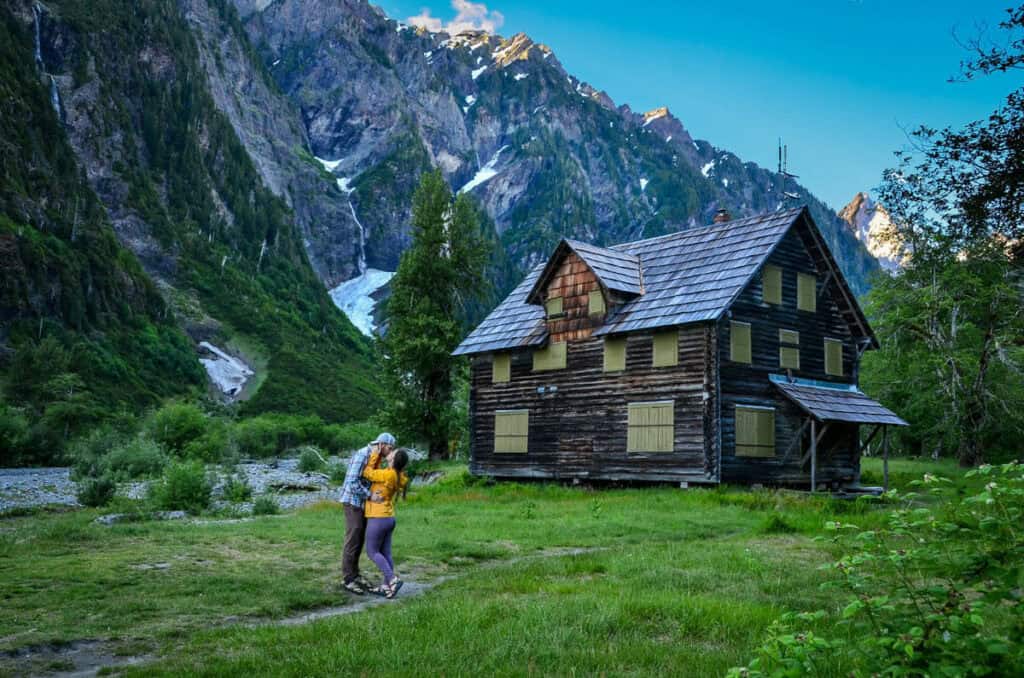
This historic chalet was originally built in 1931 as accommodation for hikers along the trail. As fun as it would be to sleep inside the Chalet, the inside of the building is now closed to the public, but still makes for a great photo opportunity!
Good to know: To be able to hike the Enchanted Valley Trail, a backcountry permit is required. The permit is easily obtainable online from the U.S. National Park website. You can pick up your permit at one of the nearby ranger stations in Port Angeles or at the Quinault Ranger Station, which is close to the trailhead.
Sound like something you’re interested in? Read more about hiking the Enchanted Valley Trail and plan your visit. It’s definitely one of our favorite backcountry experiences we’ve had in Washington!
10. Have a soak in Sol Duc Hot Springs
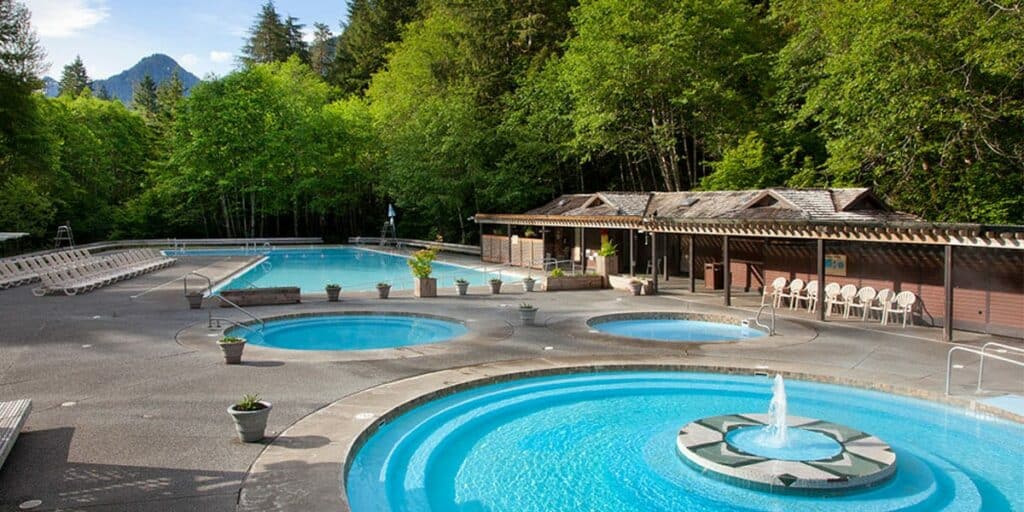
Situated right in the heart of Olympic National Forest, Sol Duc Hot Springs is one of many Washington hot springs you won’t want to miss!
More of a ‘glamping’ hot spring experience than a rugged soak, Sol Duc Hot Springs Resort offers a variety of natural spring-fed pools for a relaxing and immersive experience.
Read our complete guide to visiting Sol Duc Hot Springs on our sister site for all the information you need to plan your visit.
11. Hike to Marymere Falls
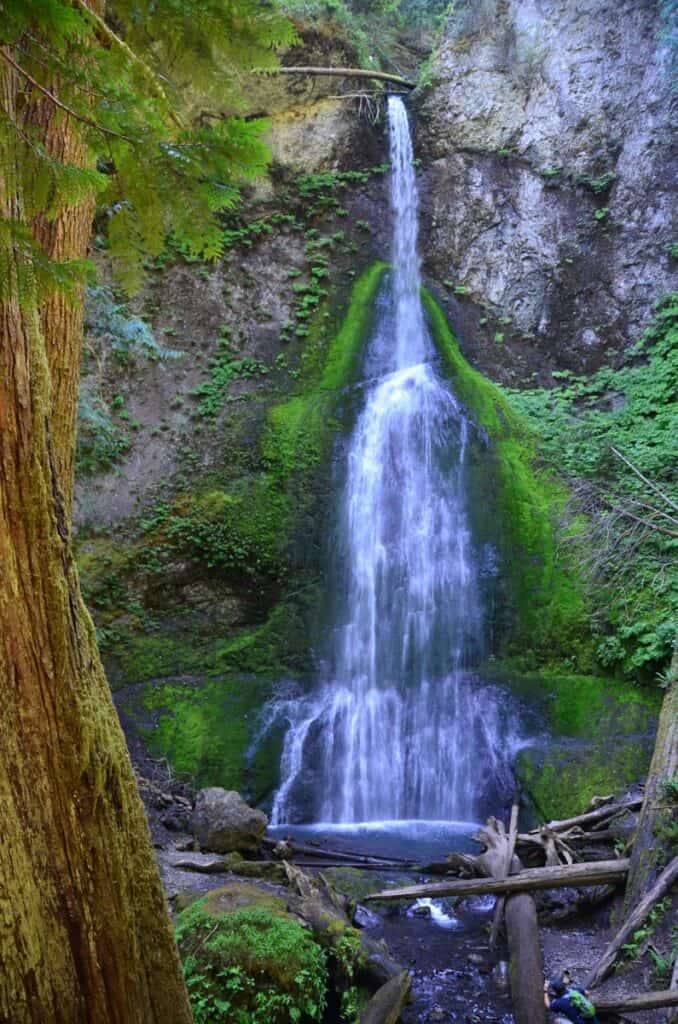
Located near the shimmering Lake Crescent in Olympic National Park, the Marymere Falls Trail offers a spectacular hiking experience in under two miles.
For those seeking a picturesque waterfall hike that is short and easy, the hike to Marymere Falls is the perfect choice.
The trail’s popularity is well-deserved, thanks to its enchanting old-growth forest, scenic bridges over multiple creeks, and the stunning 90-foot waterfall. Its ease and accessibility make it an excellent option for families.
We have a Marymere Falls Trail Guide on our sister site with more information.
12. Visit the northwesternmost point in the continental US
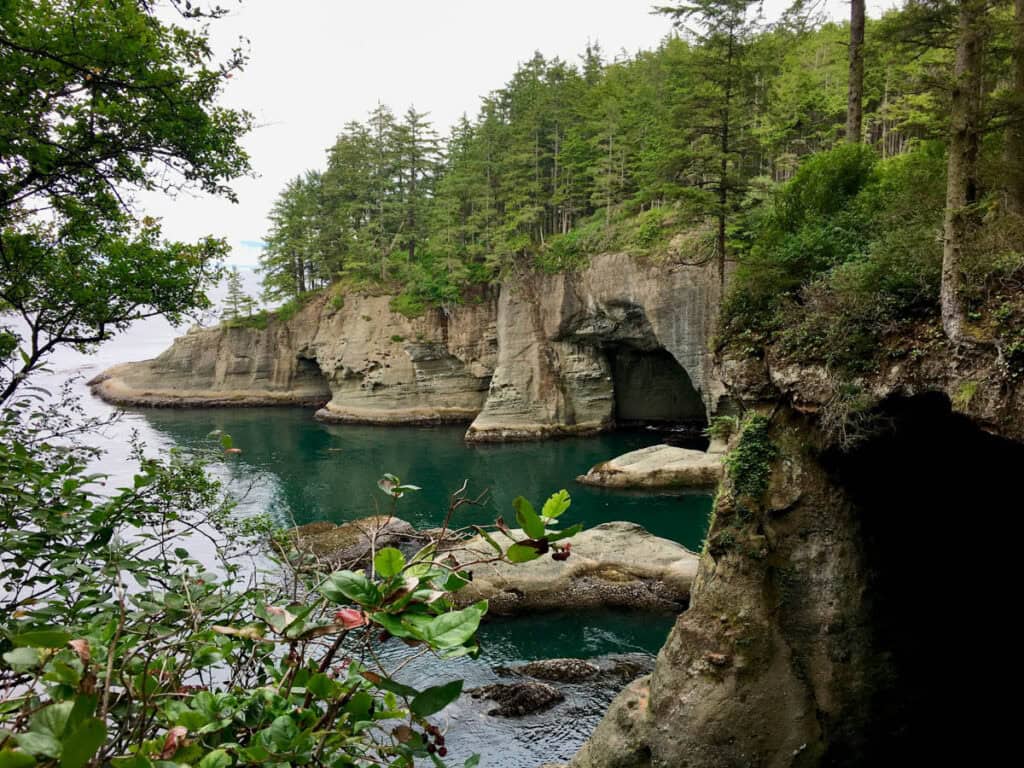
Cape Flattery is located at the point where the Pacific Ocean meets the Strait of Juan de Fuca, also the northwesternmost point of the contiguous United States.
The cape features a short, well-maintained trail that leads through lush forests to a series of observation decks overlooking the Pacific Ocean and the dramatic sea cliffs. From these vantage points, visitors can marvel at the rugged coastline, sea stacks, and Tatoosh Island with its historic lighthouse.
If you’re lucky, you may even spot a whale or two in the surrounding waters.
13. Walk to Hole-in-the-Wall on Rialto Beach
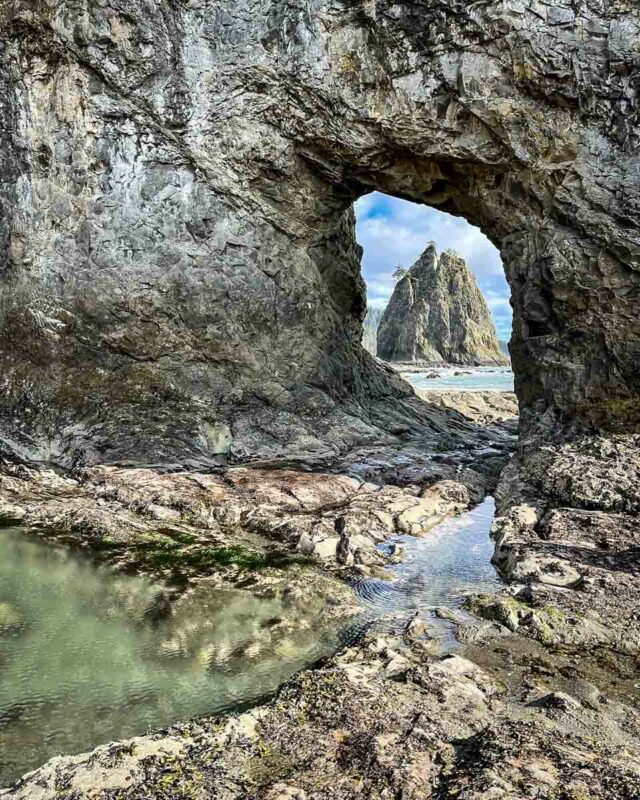
This moderate 3.3-mile round trip beach hike takes you along the rugged shoreline, with stunning views of sea stacks, tide pools, and driftwood-strewn beaches.
Stroll across Rialto Beach, past the sea stacks, and head as far up the shore as your legs will carry you. About 1.5 miles from the parking area you’ll come across a unique rock formation known as Hole-in-the-Wall.
Tip: Come during low tide or make sure you have decent waterproof hiking shoes like Chacos (our tried-and-true favorite hiking sandals!).
14. Drive to Obstruction Point
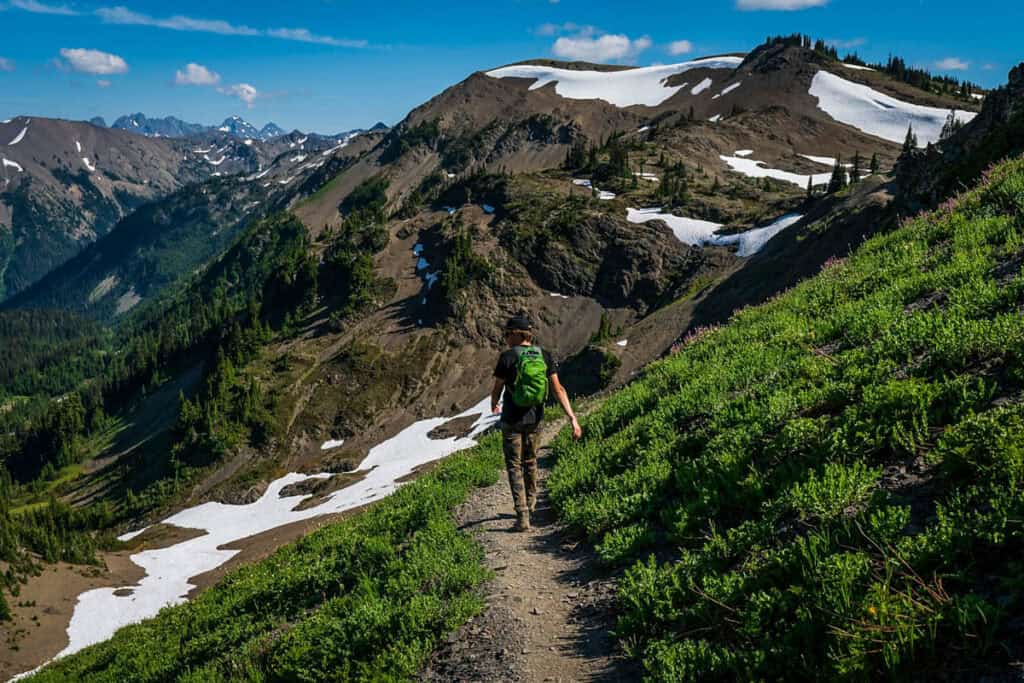
Obstruction Point Road is often regarded as the most terrifying road in Washington. Beginning at the Hurricane Ridge parking lot the alpine road ascends to Obstruction Point, reaching an elevation of 6,150 feet.
The narrow gravel road winds through the mountains with tight curves and steep drop-offs at several points. Despite the road’s challenges, the views throughout the drive are breathtaking.
Once you’ve reached Obstruction Point, there are a variety of trails extending further into the mountains. Deer Park Trail is a popular but challenging 14-mile round trip hike that begins at the point.
Note: Obstruction Point Road is generally open seasonally from July – October. You don’t need a 4×4 car to drive it, but trailers and RVs are not permitted on the road.
15. Peer over High Steel Bridge (if you dare!)
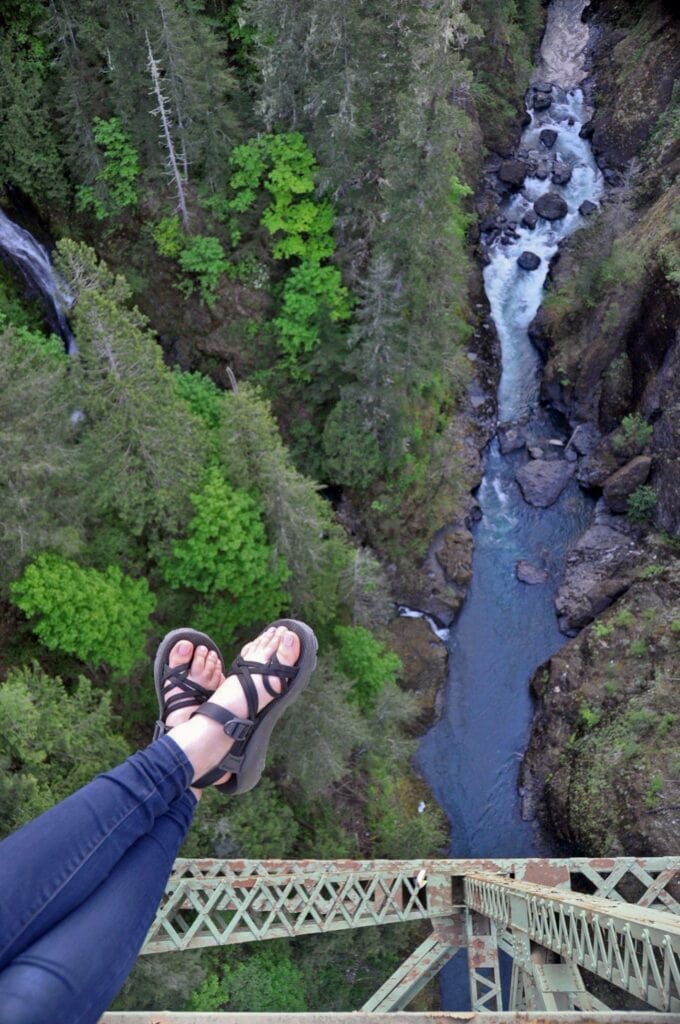
For a vertigo-inducing view, be sure to make a stop at High Steel Bridge on your way into the park.
This bridge is accessible by car and stands 427 feet over the South Fork Skokomish River. From above, you can look down on the stunning blue water in the gorge below, and you’ll even see a waterfall.
Don’t forget your camera and your common sense. Please be very cautious when taking pictures on this bridge, as the barrier (especially on the west side, is very short).
A note on this picture: Although it may look quite scary in the picture, I was actually sitting quite far from the edge, and had a barrier in front of me. Do not attempt to climb over barriers to get photos.
This bridge is more easily accessible than Vance Creek, so it can be busier. Though when we stopped here around dusk, the lighting was great and we didn’t have any company other than a group of teenagers who were throwing fireworks into the canyon to make a huge boom. (A bit frightening when you’re standing at the edge of a bridge!)
How to get there: Traveling north on Hwy 101, turn left on West Skokomish Valley Road. After about 7.5 miles, turn right on NF-2340 to this bridge, and the last portion of the road is gravel (not too bad, though). Drive across the bridge and park at the turnout point. You can walk back over the bridge, but be cautious – on one side, the barrier is pretty short and you could easily fall if you’re not careful.
16. Make a pit stop at Vance Creek Viaduct
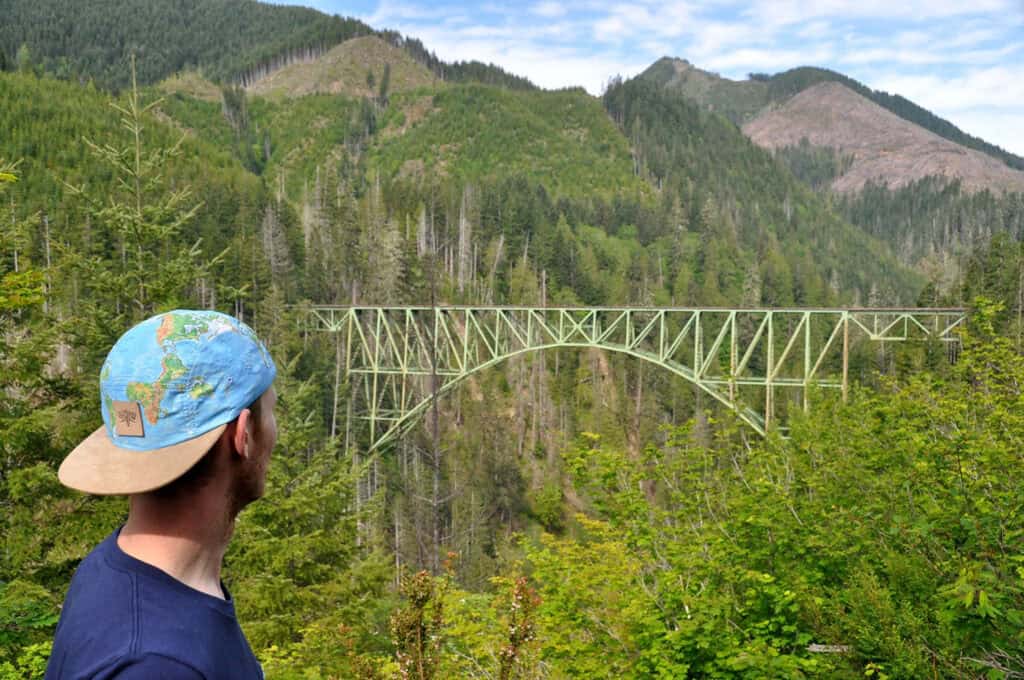
These old railroad tracks became an Insta-famous PNW landmark in the last few years. If you Google it, you can see images of people walking across this rustic wooden bridge, though when we visited (May 2017), we found a very different view.
The entrance to the bridge has been torn away and there is no way to get on top. I’m assuming that people wandering out on this bridge without any barriers led to some dangerous situations and the owners of the land decided to make it impassable.
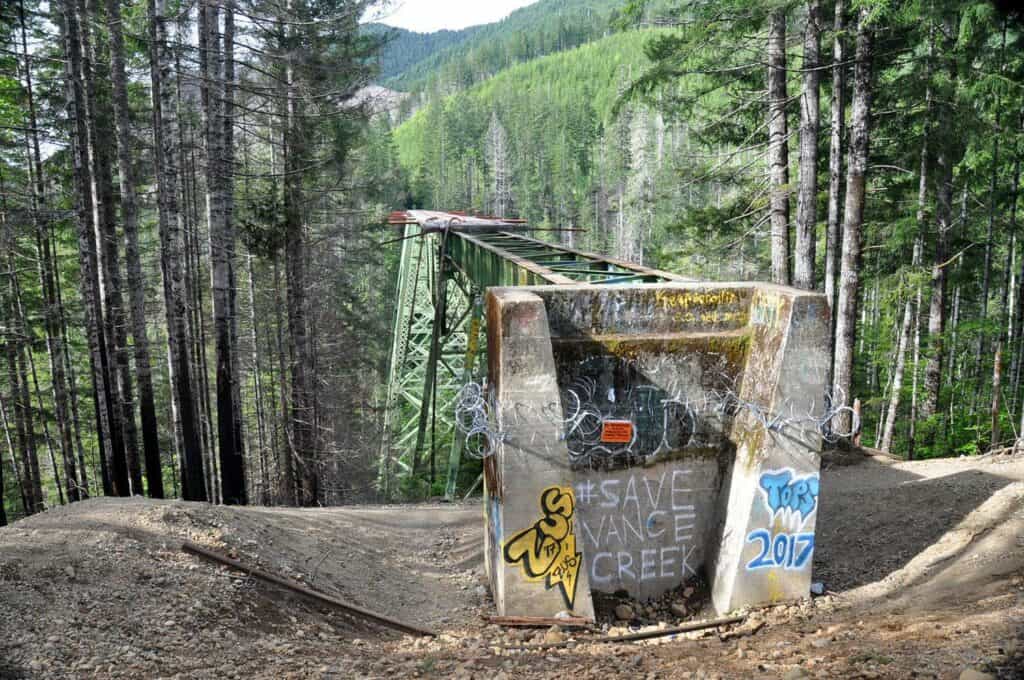
You can still walk a little ways and get a nice view from the side, but don’t make a special trip here if you are expecting to walk across, because you’ll be disappointed.
How to get there: Take the same West Skokomish Valley Road as in the High Steel Bridge. Instead of turning right, continue on NF-23 (still a gravel road) until it becomes payment again in about 300 yards. Park your car and you will see a gate that blocks cars from accessing the road on the right (the second orange gate).
It is private property, but there is a sign that says you are free to walk to the viewpoint. After about 100 meters, you will come to a Y in the path. To the right is the actual bridge (but again, you can no longer access the bridge), and to the left is a 0.6 mile walk on a wooded path that will lead you to the viewpoint.
Note on both bridges: There’s not much else to explore in the vicinity, so if you’re really pressed for time you could skip these bridges in your Olympic National Park itinerary.
17. Sequim
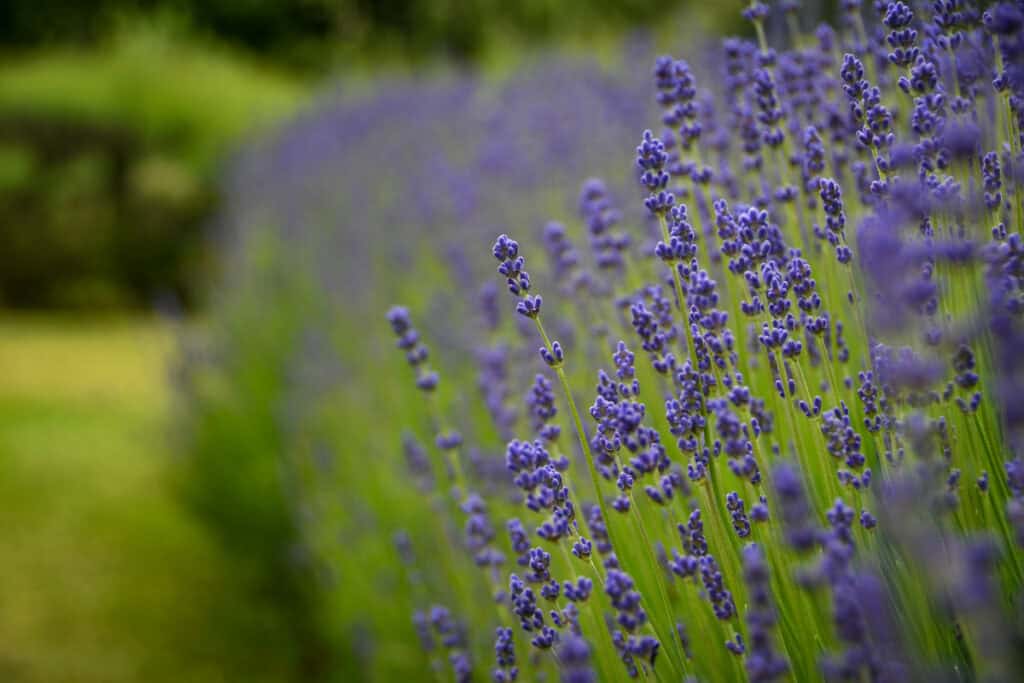
This small town is best known for lavender fields and sunshine—sounds lovely, doesn’t it?!
If you’re traveling in the Olympic Peninsula during the summer months, be sure to check out the lavender, and you might just get lucky and hit their festival celebrating this pretty flower which falls in mid-July.
Foodie Tip: If you’re looking for a special meal, Nourish is an organic farm-to-table restaurant that sources ingredients from the onsite gardens. They have gluten free, dairy-free and vegan options, and inventive menu items.
18. Forks
If you’ve read the Twilight series (guilty as charged!), you’ve heard of this town as it’s where this tween sensation takes place.
We needed to fill up on gas and groceries, so we stopped in Forks. Okay, that’s just my way of making up an excuse… Let’s be real, I wanted to check it out too!
Was it what I expected? Not really. Let’s just say the towns in the Olympic Peninsula certainly aren’t the draw here. The main road has a couple restaurants, hotels and gas stations, some with Twilight-inspired names.
If you’re a fan you’ll probably want to stop and check it out. And being that it is quite near Olympic National Park, by all means go for it. But don’t plan to spend too much time here. There’s not really much to it. I didn’t even take a single photo… and I take photos of everything.
19. Port Angeles
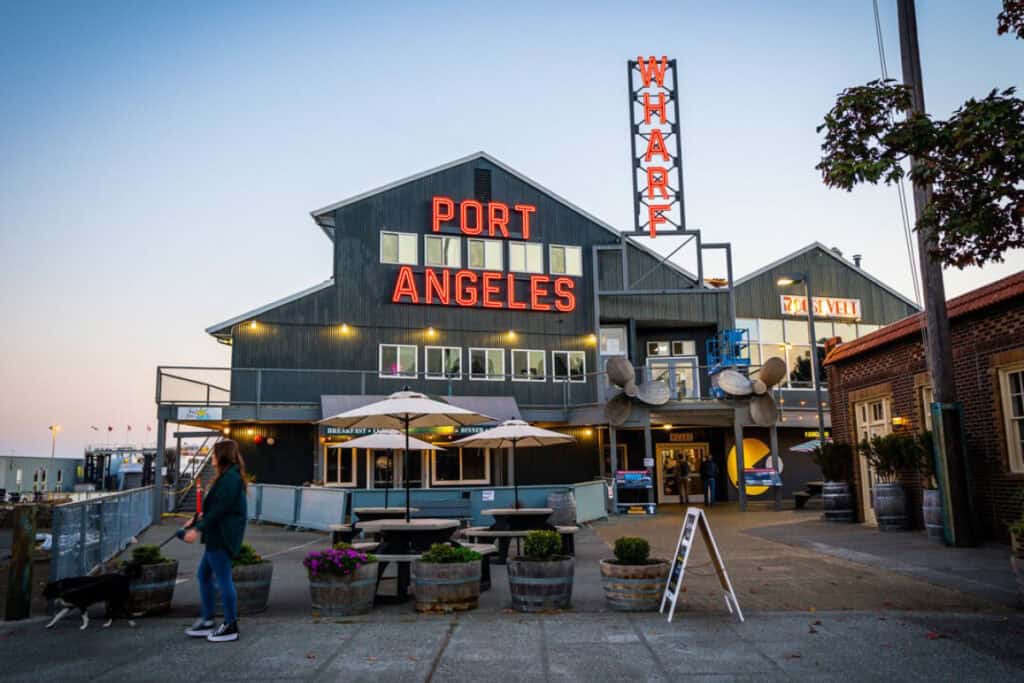
With a population of 20,000 people, this is by no means a big city, but it’s the largest you’ll find on the OP.
We wouldn’t necessarily recommend spending much time here. You don’t come to the Olympic Peninsula for the towns, after all. That said, it’s a good point to stretch your legs after some driving, pick up any groceries you need, and fill up the gas tank.
And the main reason to stop here is to stop at the Port Angeles Wilderness Information Center to pick up any necessary permits you’ll be needing. For instance, this is where we stopped to get our permit to camp on Shi Shi Beach and pick up a bear canister.
The visitor center is where you can also check trail conditions, weather, and chat with rangers about any questions you might have.
There are also a handful of good restaurants and breweries in Port Angeles if you’re looking for a bite.
Olympic National Park overview
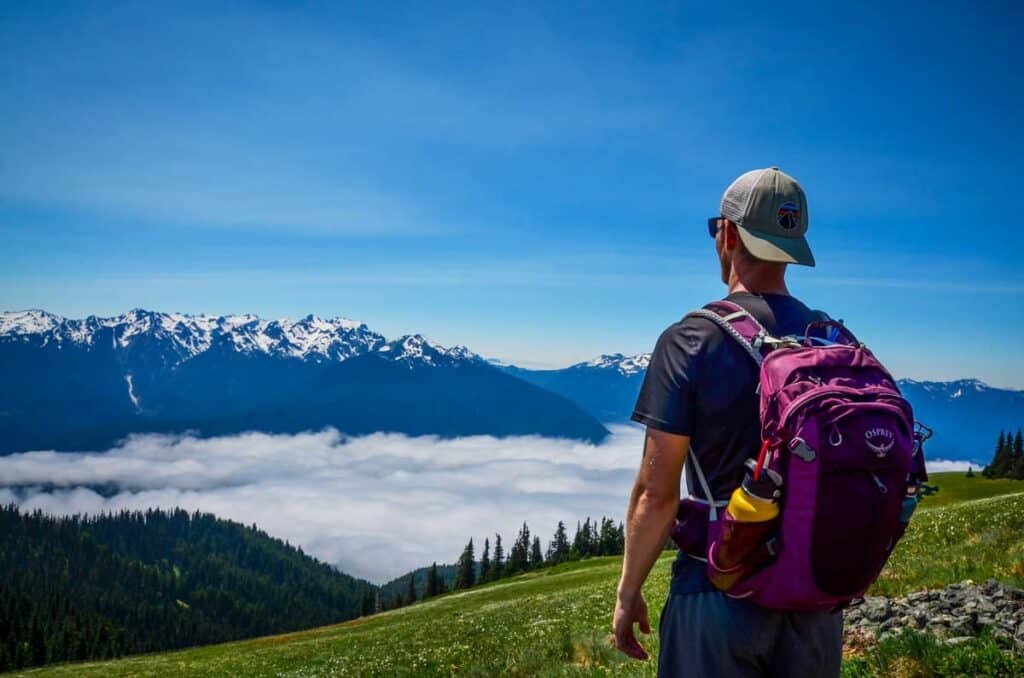
- Open: Year-round (some seasonal closures from October – May)
- Entrance Fee: $30/vehicle, $25/motorcycle, $15/hiking & biking, or free with your America the Beautiful Pass
- Wildlife: Black bears, dear, elk, bald eagles, whales and sea otters are among the wildlife frequently spotted in the park
- Established: June 29, 1938
- Ancestral Lands: Given the size of Olympic NP, 8 tribes called this land home; Hoh, Jamestown S’Klallam, Lower Elwha Klallam, Makah, Port Gamble S’Klallam, Quileute, Quinault and Skokomish.
- Area: 922,650 acres (3,733.8 km2)
Best time to visit the Olympic Peninsula
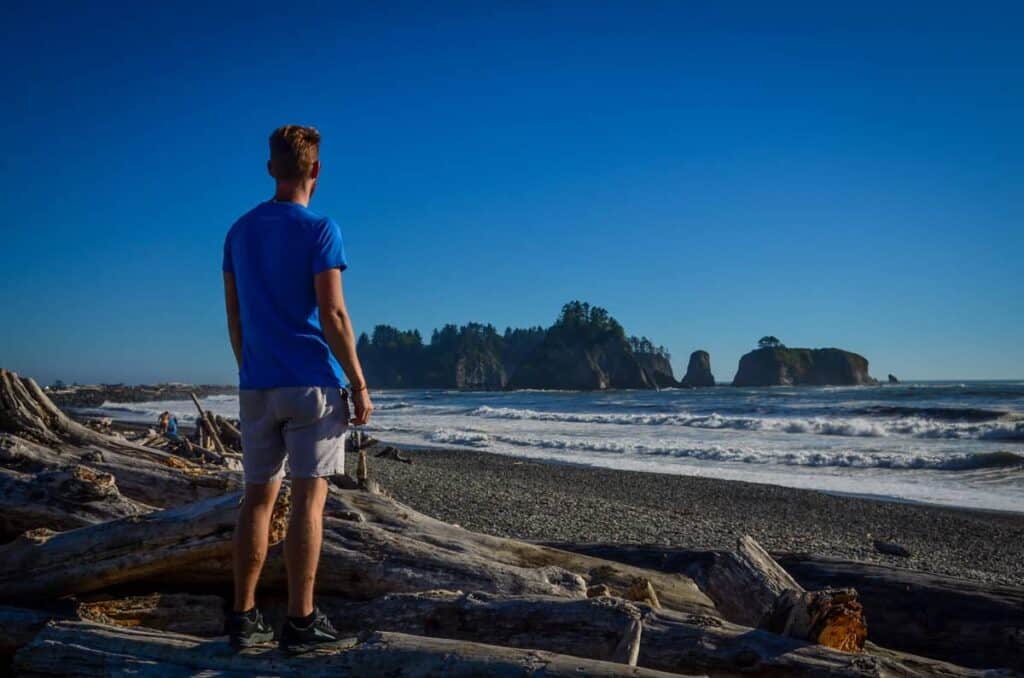
Being that the Olympic Peninsula is, well, surrounded by the ocean on most sides, the weather here tends to be milder than further inland.
For the best chance of sunny, dry and warm weather, July and August are a good bet. This is also the most popular time to visit, so popular attractions will be at their most busy.
If your travel dates don’t fall during the summer months, don’t worry! Some of the beauty of this region is the moody, foggy weather you’ll find in the spring, autumn and even winter months. While you can’t be upset about a sunny day, we actually think the mist that’s common on the OP gives it a beautiful and mysterious aura.
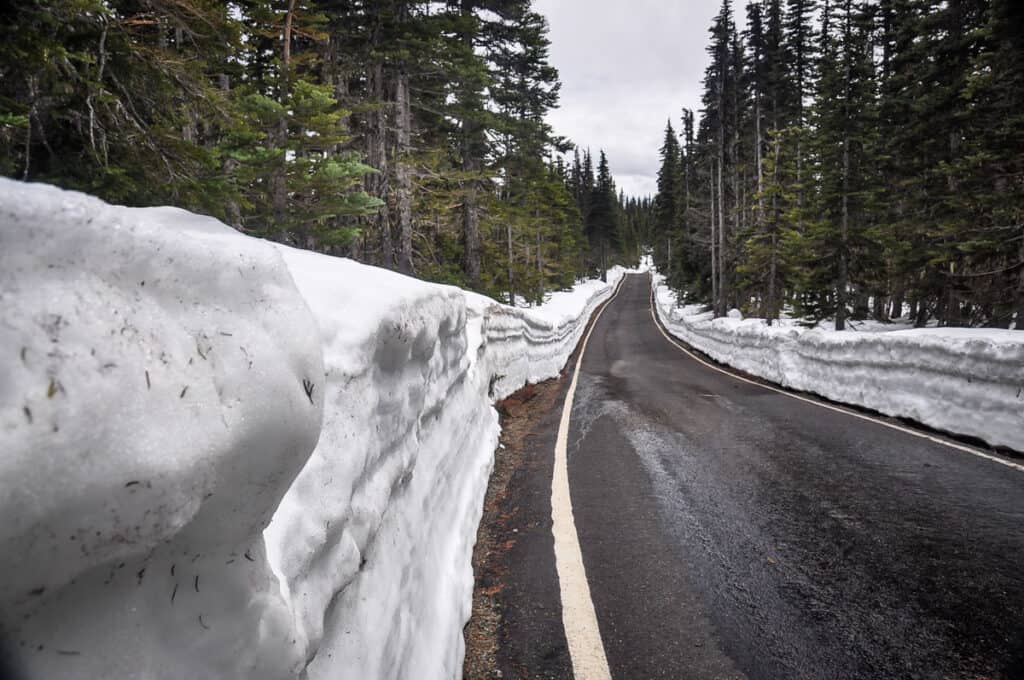
Good to know: From October through May, you can expect some roads, campgrounds and visitors centers to be closed or have shorter hours. Be sure to check before your trip.
How many days to spend in the park
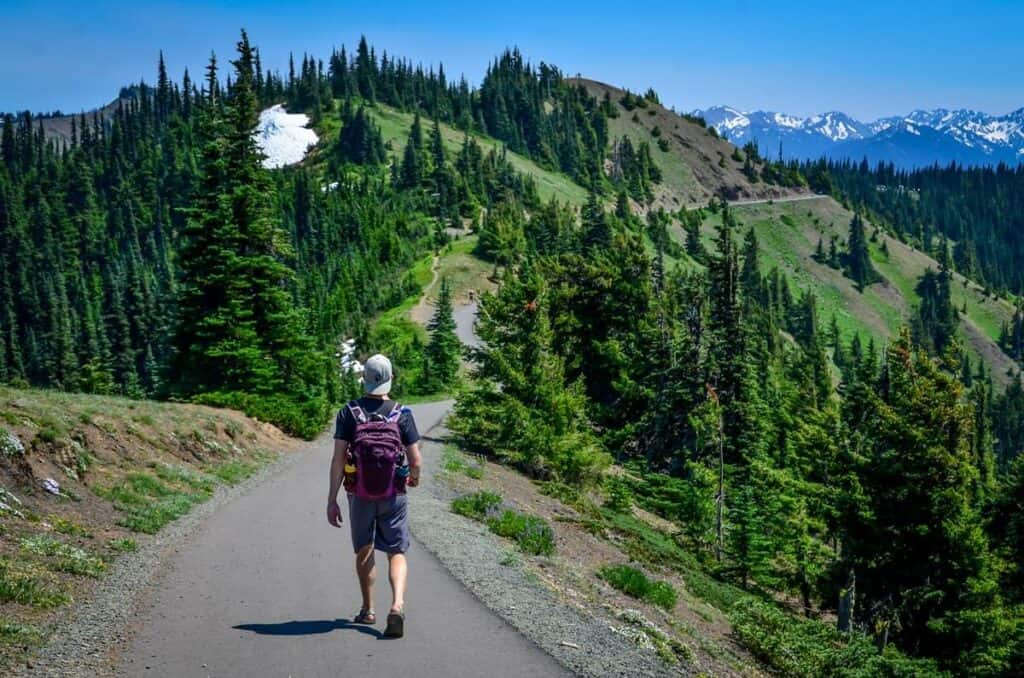
We’d recommend 2 – 4 days to cover all the best things to do in Olympic National Park.
If you’re planning on making quick stops at each of these areas, you could probably see everything in two days. It would be really rushed and lots of time spent driving. You could also stretch this out to a week, taking more time to linger in each place and add in a few more stops.
We spent 4 days on the Olympic Peninsula, and thought it was a good amount of time, especially if you plan on camping at any of the beaches.
How to get there
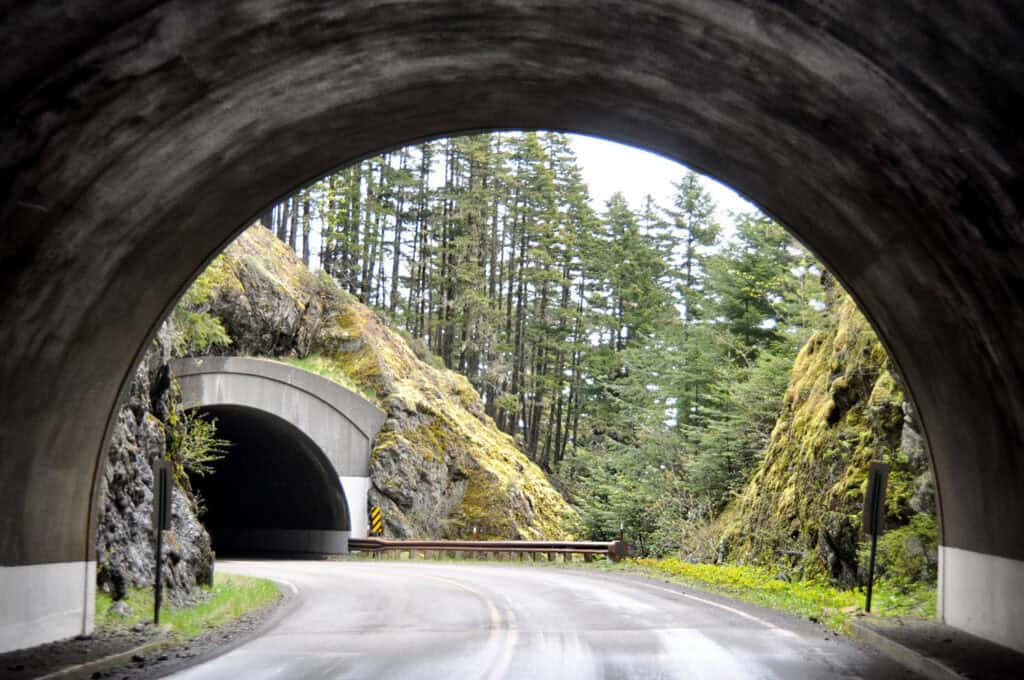
If you’re planning a road trip to Olympic National Park, you’ll likely be starting and ending this journey in Seattle.
Before leaving the city, be sure to grab some strong coffee for the road. You’re gonna need it!
Insider tip: And if you’re from out of town, be sure to read up on all the fun things to do in Seattle—it’s a really great city to explore, and you should definitely allocate a few days to seeing all the sights (and drinking all the craft beer!).
There are essentially 3 ways to get to the OP from Seattle:
- Take the ferry to Bainbridge Island: This is a shortcut and will save you a bit of time. You will miss some stops on this route (like #15 and #16) if you come via the ferry.
- Drive through Olympia: This drive will avoid the ferries and add 180 miles and 3.5 hours onto your trip. It also gives you the opportunity to see a bit more. And that’s the fun of a road trip right?!
- This is the option we chose for our road trip.
- Drive through Tacoma and head north to Bremerton: If you don’t care about seeing the High Steel Bridge or Vance Creek Viaduct, you could instead drive through the small towns of Bremerton and Port Townsend. The routes will converge in Sequim (#17 on this list).
Entrance fees and tickets
- Private vehicle: $30, valid for 7 days
- Motorcycle: $25, valid for 7 days
- Per pedestrian: $15, valid for 7 days
If you’re planning to visit more than one of the U.S. National Parks, we’d highly encourage you to look into getting an annual park pass. At $30 per vehicle, entering Olympic NP along with other national parks in the U.S. can get expensive.

For just $80 per year, you can purchase the America the Beautiful park pass. This pass grants you free access to all of the national parks. Plus it also covers your entrance to over 2,000 natural, historical, and recreational sites across the United States.
→ If you still need convincing, check out our article: America the Beautiful Annual Park Pass: Is it Worthwhile?
Getting around in Olympic National Park
Getting around Olympic National Park without a car can be challenging due to the park’s vast size and limited public transportation options.
While there are some shuttle services and tour companies that offer guided excursions within the park, we’d highly recommend having your own vehicle to do some exploring.
Wanna try out vanlife while visiting Olympic National Park?
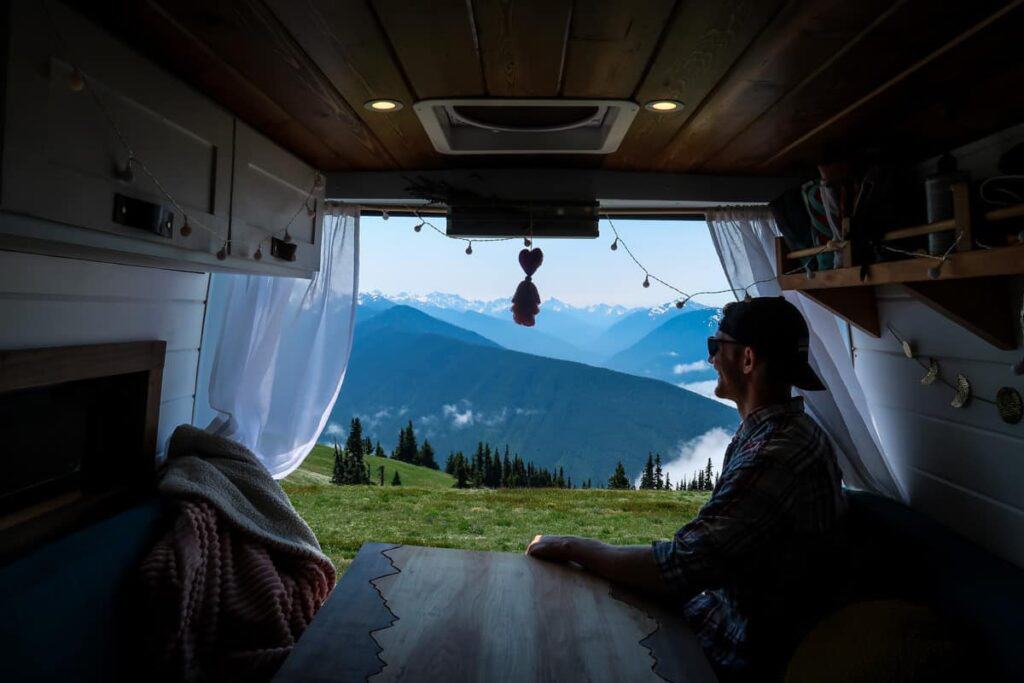
It’s no secret we’re obsessed with #vanlife. If you don’t have the time (or interest!) in building your own conversion but you still want to give van life a test drive, we’ve got some ideas for you…
Check out our list of top companies for USA Campervan Rentals, from budget to bougie, we’ve even included some exclusive discounts for our readers!
One company we’d recommend looking into is Escape Campervans. They have 12 different locations across North America (including Seattle!) and come fully loaded with all the gear you need for an epic road trip. Plus, their rates are fair and affordable.
BONUS: We’ve partnered with them to give you a 10% off discount when you use our link!
We have plenty of recommendations for campervan-friendly campsites in our Olympic National Park camping guide.
Olympic National Park map
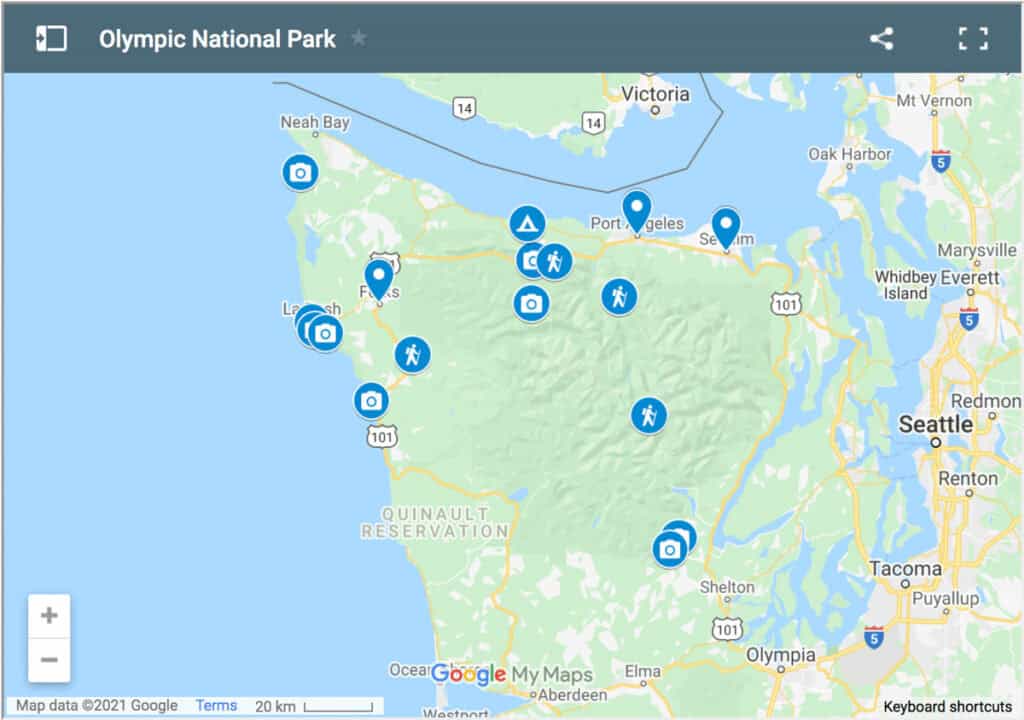
The Olympic Peninsula is one of the best places to take a road trip in the US, and we are excited to help you plan your trip!
We’ve put all of the stops onto a map so you can visually see where we’re talking about. We’ve laid them out in an order we would suggest for the ideal Olympic National Park itinerary, but you could visit them in any order you’d like.
Click on the map above to be taken to the interactive Google Map.
Where to stay in/near Olympic National Park
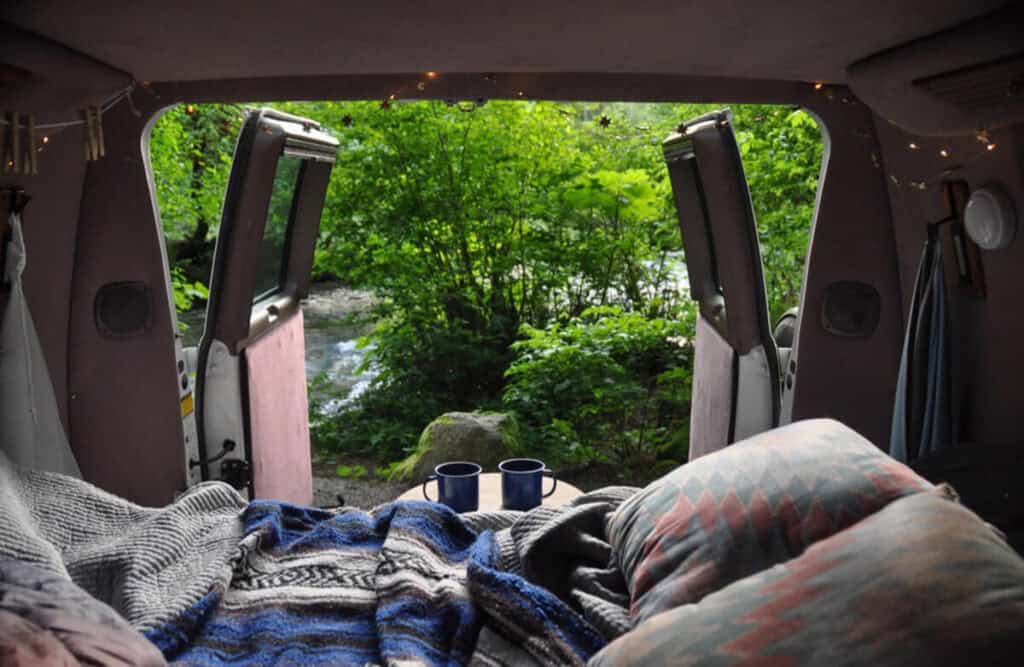
If you’re planning to camp in a tent or campervan, you’ll have plenty of spots to choose from all over the OP. And if camping just ain’t your thang (that’s cool too!), there are some cozy places to stay in the Olympic Peninsula that’ll make it hard to leave!
We have a complete guide for where to stay in Olympic National Park that has a rundown of all of our favorite campsites as well as some alternative lodging options.
We highly recommend camping in Olympic National Park, but if you prefer a roof over your head, here are some notable lodges:
- Lake Crescent Lodge: This iconic lodge offers a charming and historic retreat on the shores of the stunning Lake Crescent. Established in 1915, the lodge provides a range of accommodations from cozy lodge rooms to rustic cabins, all surrounded by the natural beauty of old-growth forests and crystal-clear waters.
- Lake Quinault Lodge: A historic and elegant getaway on the shores of Lake Quinault. Built in 1926, this grand lodge exudes rustic charm with its cozy rooms and inviting fireplaces, offering a peaceful retreat amid lush rainforests and pristine lake views.
- Kalaloch Lodge: Perched on the rugged Pacific coast, Kalaloch Lodge offers breathtaking views of the sea. This rustic lodge provides a range of accommodations, including cozy cabins and lodge rooms, all designed to blend seamlessly with the natural surroundings of Kalaloch Beach.
- Olympic Lodge: Located near the entrance of Olympic National Park in Port Angeles, Olympic Lodge makes a comfortable and convenient base for exploring. This modern lodge features spacious rooms with stunning mountain views.
What to pack for visiting Olympic National Park
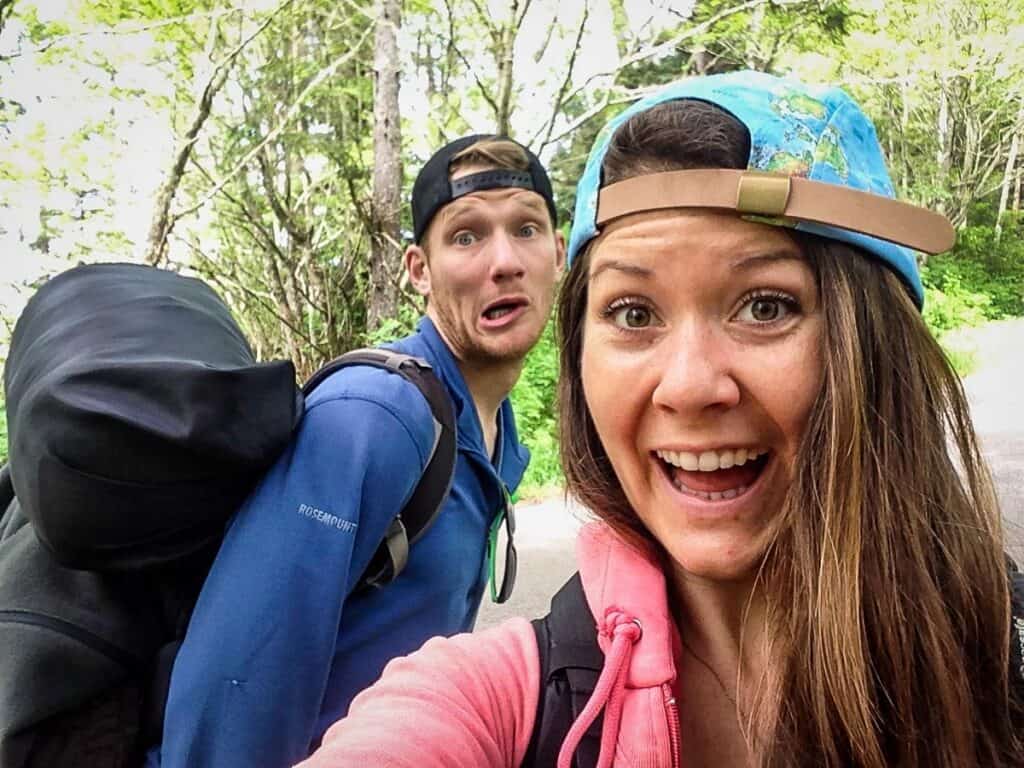
The landscape diversity of Olympic National Park–not to mention its sheer size–means you’ll want to come prepared for all kinds of situations when visiting. Here are a few key items you’ll want to make sure you pack.
- Navigation: AllTrails Pro (or download Google Maps offline for the area in case you lose service)
- Get your first week of using Alltrails+ for FREE when you sign up using our link!
- Comfortable daypack
- Rain jacket: Doesn’t matter what time of year, it’s always good to be prepared in rainy Washington!
- Anker Charger: Keep your electronics charged while hiking and on the road!
- Insulated water bottle
- Bug repellant
- Comfortable hiking clothes (always dress in layers!)
- Sturdy waterproof shoes: We’re obsessed with Chacos, and they were pretty much all we wore during our trip in Olympic National Park. They are good for long walks, hiking, beaches, and can get wet.
- Sunscreen & hat: Even if it’s cloudy
- Camera and tripod (this is our favorite for hiking)
- Headlamp: If you’re camping, this should be a must in your packing
- Tent, sleeping bag & cookware: If you plan to do any tent camping along the way
- Food: There aren’t a ton of grocery stores along the way, so it’s best to stock up on your favorite snacks, groceries (if you plan to do cooking), and beverages in Seattle.
- Check out some of our favorite hiking snacks for ideas!
Round up of things to do in Olympic National Park
Here’s a recap of all the best things to do in Olympic National Park so you can see everything in one place.
- Hoh Rainforest
- Hurricane Ridge
- Sol Duc Falls
- Shi Shi Beach
- Mount Storm King
- Lake Crescent
- Beaches in La Push
- Ruby Beach
- Enchanted Valley
- Sol Duc Hot Springs
- Marymere Falls
- Cape Flattery
- Rialto Beach
- Obstruction Point
- High Steel Bridge
- Vance Creek Viaduct
- Sequim
- Forks
- Port Angeles
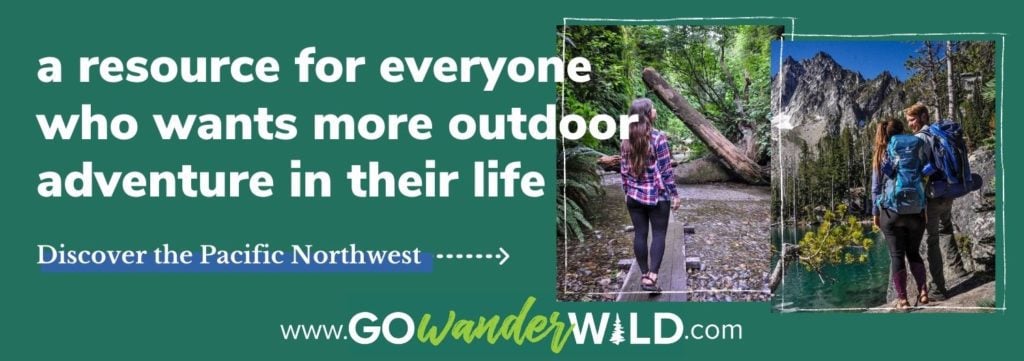
Planning a trip to the PNW?
- Find out exactly where to stay in Olympic National Park.
- You’ll want to check out the best Olympic National Park hikes.
- And don’t miss the top places to see in Washington State (our favorite US state!).
- Read up on all the fun things to do in Seattle.
- For a taste of #vanlife, choose from the best campervan rentals in Seattle.
- And while you’re in Washington, check out the cutest little town in the state: Leavenworth (we lived there for 8 months and have all the local secrets!).
- Headed south? Check out all the unique things to do in Portland.
- Plus, you’ll want a list of the best places to visit in Oregon!
Want to explore the PNW like a local?
If you want to save yourself hours of research planning your Pacific Northwest road trip, we’ve got something you might be interested in…
We create the ultimate resource for traveling in our home-region. Our custom PNW Map includes our top recommendations in Washington and Oregon, (including all 4 national parks in the region!).
We loaded this map with all of our favorite spots, personal tips and photos, and hidden gems we’ve run into as we continue to explore our little corner of the world.
This custom Google Map will help you navigate the PNW like a local!
Love exploring USA National Parks?
Us too—in fact, we’re kind of obsessed with them!
We have tons of articles, guides, and itineraries for just about every national park we’ve visited. Browse our USA National Parks homepage or click on one of our national park guides below.
- Acadia National Park, ME
- Arches National Park, UT
- Bryce Canyon National Park, UT
- Canyonlands National Park, UT
- Capitol Reef National Park, UT
- Death Valley National Park, CA & NV
- Glacier National Park, MT
- Grand Teton National Park, WY
- Joshua Tree National Park, CA
- North Cascades National Park, WA
- Rocky Mountain National Park, CO
- Yellowstone National Park, WY
- Yosemite National Park, CA
- Zion National Park, UT
Save this article on Pinterest for later!
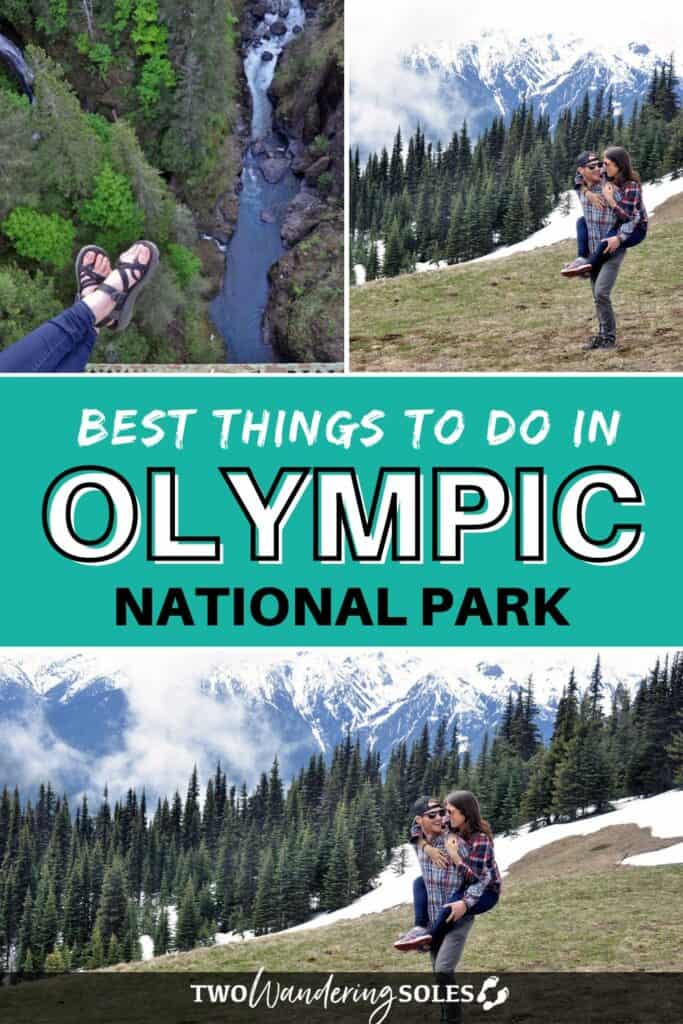

We want to hear from you!
Which of the adventurous things to do in Olympic National Park is going straight to the top of your bucket list? Are you planning a trip to Washington’s Olympic Peninsula and still have questions? Comment below and we’ll do our best to get back to you!

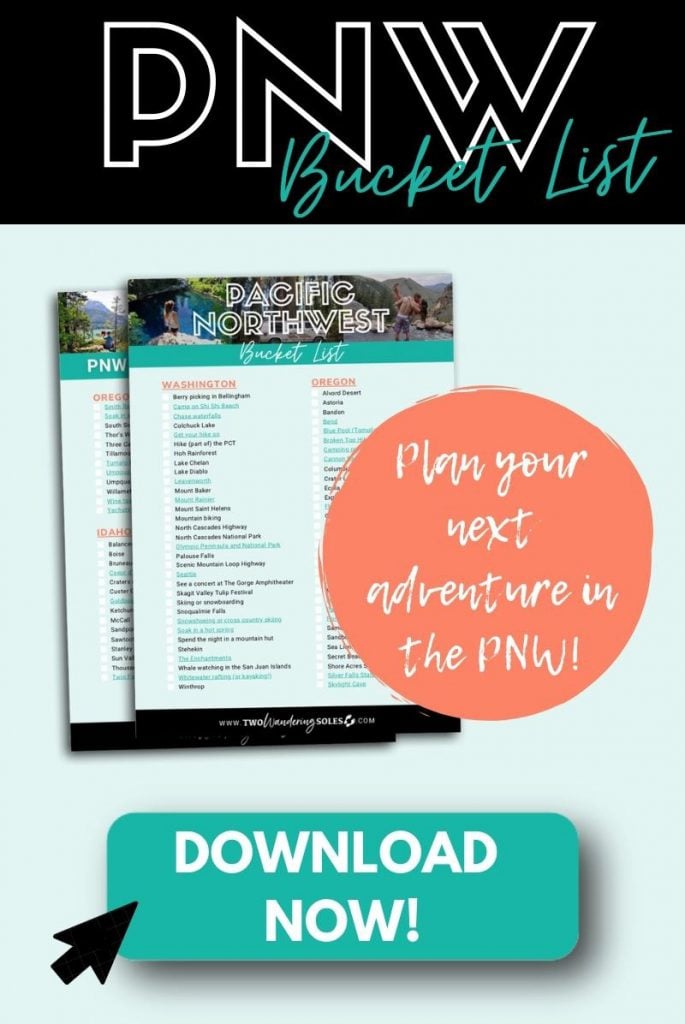
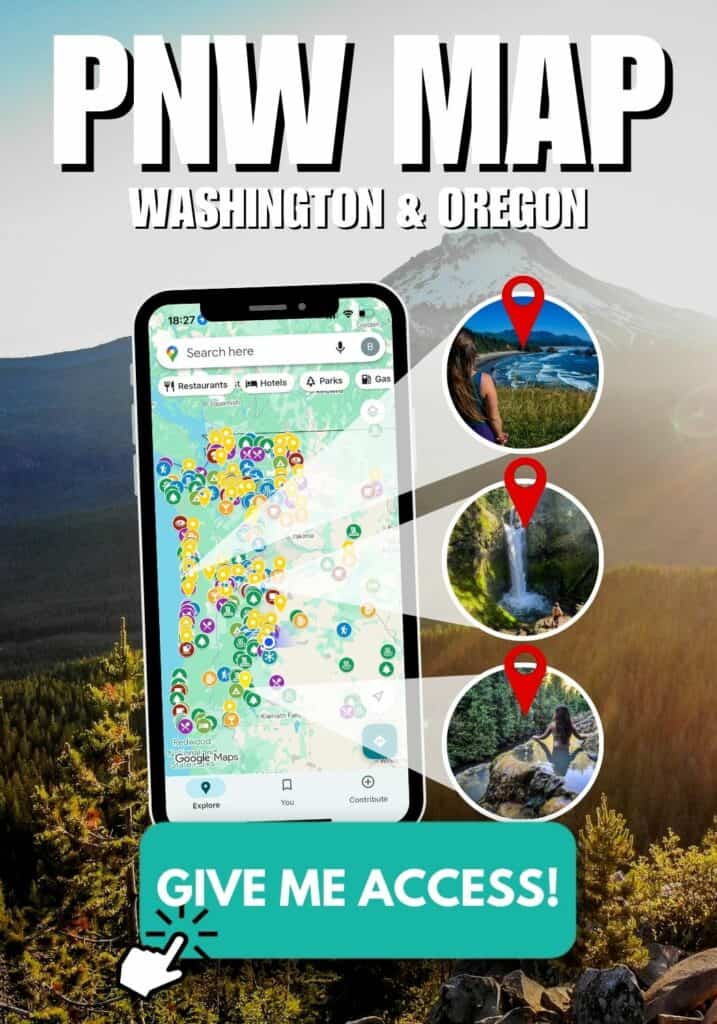
This makes me want to explore the PNW even more! I’ve only visited national parks in the south, but this biome is so diverse and like nothing I’ve ever seen. Just based on your recommendations, I think Shi Shi beach would be my favorite.
The trek to see that view would be so worth it in my opinion! Thank you for sharing, I hope to plan my own trip to the Olympic Peninsula soon!
An Indian here. This was the kind of blog I’d been searching for. Felt as though I was in your shoes travelling to these amazing places. Really wish to travel to the “Land of the free”. May be one fine day.
Good article. Such a valuable information provided here.
RV Parks In Branson
My husband and I had a chance to visit ONP a few Thanksgivings ago. We loved it and saw a lot, but only had one day. It’s a good start, but even though some of the routes were closed for the winter, that just didn’t cut it. Agree with you that the park deserves 2-4 days. Maybe 2 in the winter, but if I were to go back, I’d go in the warmer months and give it the full 4 days.
Thanks for all the tips. I love the content
Hi Katie and Ben! 🙂
We’re about to head to OP in Sept. thanks for your tips and trick from this article and the Seattle blog. Hope your wanders have found you someplace else fresh and exciting. Safe travels… Minnesota girl. Tami
This website is one of the most poorly designed sites I have ever attempted to get information from. Your “interactive map” is half covered by a permanent Mediawave ad that makes it impossible to see the whole map. Every other part of your site is impossible to navigate, again because each page is half covered in ads.
Where is your actual content? It’s sites like yours that makes travel blogging such a nightmare. The information is there….somewhere.
Hi there Jenowa, thank you so much for your feedback. I made an adjustment to the interactive map so you can see/use it better.
As for the ads, just like everyone else, I’m not the biggest fan of them. Who is really? However, travel blogging is our full time job and has been for the last few years. Advertisements are one of the ways we make a living and are able to produce all this FREE content for you and thousands of other readers each day.
If you would like, we can set up a monthly payment plan where you can view our detailed articles ad free. Please let me if your willing to pay for our content. But until then, unfortunately, the ads will remain.
Thank you for your understanding and thanks again for your feedback.
Awesome! Where’s the spot of your first photo from camp van?
Hey Jake, the first photo for the campervan at a campsite is at Lyre Campground. It’s one of our favorites in the OP.
Hey Katie & Ben, Im curious to know. Where did you rent your camper van from? Hope to hear back from you! Thank you
Hi Lily, thank you for your comment. We actually bought and build out our campervan ourselves 🙂 You can find out more about our budget campervan build on our Campervan Page.
If you’re looking for a budget rental, we’d recommend Escape Campervans. They have everything you need, easy to drive, and many locations. Check them out here (Affiliate Link): https://ssqt.co/mQgA8oj
Wow Olympic National park sounds like the place I want to visit..lovely pictures ,I would love to experience vanlife sometime for sure
The OP is one of the National Parks I am itching to get back to!
This blog post makes me so excited to explore more of the US! I usually only travel overseas, but there is so much beauty here as you have shown in your post!
So much natural beauty!
Great photos! I’d love to get back out to WA and spend some time in nature.
One of our favorite places in the world!
Would you recommended traveling to the OP the first week of May? Me and my boyfriend would absolutely love to come here, but unfortunately the first week of May is our only option. Should we look into other national parks instead?
Hey Hal, the OP may be snowy and cold on the first week of May. So if you’re prepared for that, you’ll have a good time. We were there near the end of May 2017 and it was still pretty cold and snowy.
Awesome blog!! I really enjoyed while reading your amazing blog, Pics are so attractive, I cant take my eyes off!! This blog made me so excited about USA.
Thanks so much Raj!
Nice job guys. I really loved the post and the way you described all the spots. I am going to OP and Mt. Rainier around end of June, have been waiting for this trip for ages. When did you guys go and how was the weather around at that time.
Hey Sunny, We were there near the end of May 2017. Hurricane Ridge just opened up as a viewpoint, but the rest was still snowed in. The rest of the areas were pretty nice and not too busy yet. It’s a rainforest so of course it rained on us nearly everyday but that’s to be expected. Hope this helps.